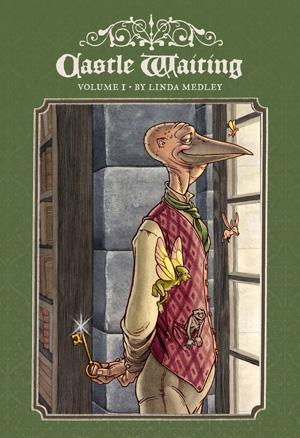Comic Book Review: Castle Waiting Volume 1 by Linda Medley
Once upon a time there was a castle whose inhabitants had slept for a hundred years. You may have heard of it long ago. But the princess who woke went off with her prince, abandoning her people who in turn abandoned the kingdom. The castle itself remains, waiting for a new king or queen–but until then it is a refuge for those who need it.

This fantasy comic book series takes place in a world inspired by fairy tales. The initial story is a fairly straight-up adaptation of Sleeping Beauty with a bit of a twist at the end. The story turns out to be told by the last of the “original” inhabitants, the princess’ handmaidens, now elderly, to a stork-headed man, Rackham, who is the new adjutant.
The story proper begins some years later, as a pregnant woman named Jain seeks a safe place to have her baby. After a couple of adventures, she arrives at the castle and is greeted by the odd assortment of long-term residents. There is a certain amount of mystery involving the exact events of Jain’s past, and just who the father of the baby is.
There are bits with various castle inhabitants revealing more of their character and purposes. And the last half of this volume is a deep dive into the past of Sister Peace, which is Scheherazade like, containing many other stories within it. Peace is of the Solicitine Order, an unusual group of holy women that honestly is the thing most people remember strongly about the series.
The black and white art is excellent, with quirky characters that inhabit a vaguely medieval world. This being a mashup of various fairy tales, however, anachronisms run wild, and geography is dubious at best.
The stories are mostly gentle in their way, with little battle. Sir Chess, the equine knight, may be a combat champion, but we don’t see any of his bouts. There’s some abuse in various backstories, but almost never seen directly. The Sister Peace story especially focuses on the notion that violence is not a good answer, and that it’s more important that people be led to find what they need, rather than what they want.
Some readers may find the attitudes of the good characters a little too modern and feminist. (They were not entirely absent from the time periods before the present.) Also, there are only two volumes to the series, and the ending was unsatisfying to a number of the fans, but the creator has moved on.
Content note: In addition to the previously mentioned abuse and bullying, there’s use of the word “gypsy” to refer to Roma, and they have a bit of old stereotypes to their portrayal as in the fairy tales of yore. Early teens on up should be able to handle it.
Overall, a satisfying volume by itself, and a solid read for lovers of a fairy tale setting.

